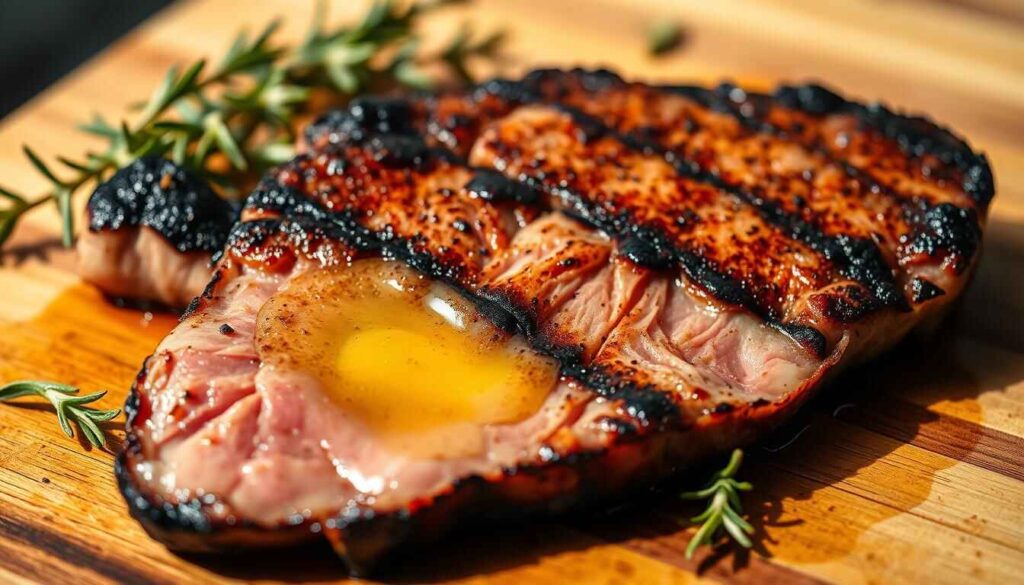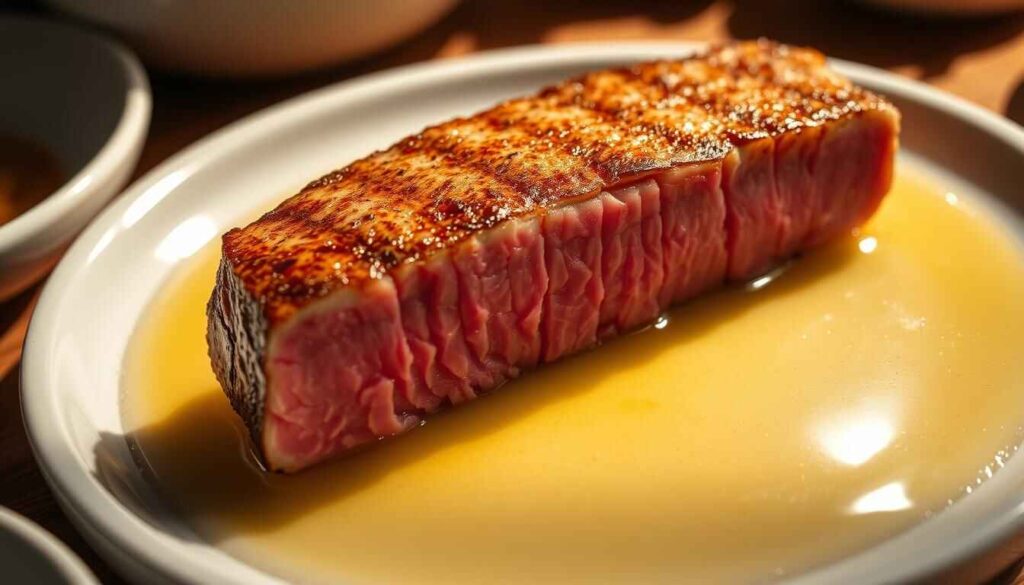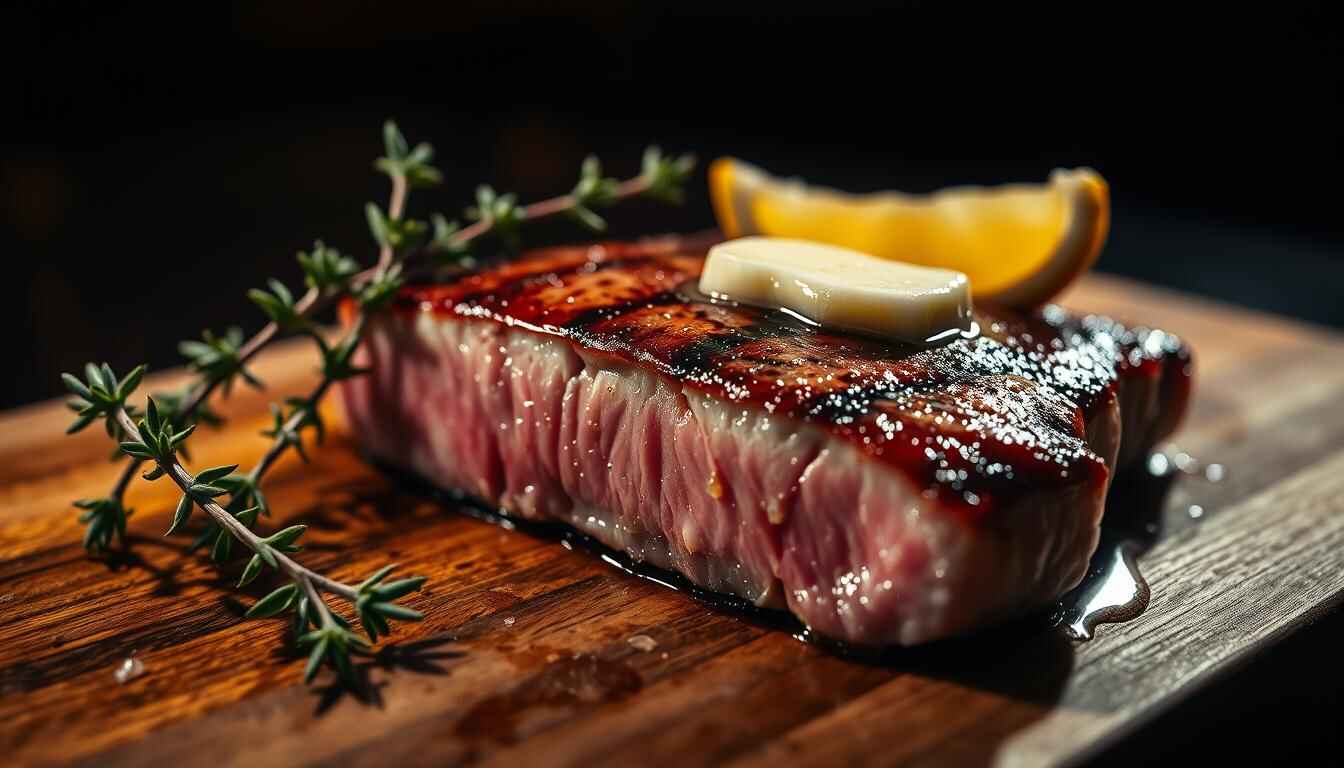How to Cook Tuna Steak in Pan with Butter
Cooking a tuna steak can be an exciting adventure, especially using a pan with butter. This technique leaves your tuna tasting rich and tender for an irresistibly delectable bite! Don’t miss out—give this dish a try today.
Follow these easy steps to learn how to Cook Tuna Steak in Pan with Butter. Searing the tuna steak correctly and adding the right amount of butter are key to successful tuna steak preparation. This buttery tuna steak recipe is not only easy to prepare but also full and very satisfying!
Discovering this recipe will show you how to recreate restaurant-quality meals at home. Let’s dive into the details of making tuna steak in a pan with butter – now is your opportunity to get cooking!
Table of Contents
Understanding Tuna Steaks
To craft delicious tuna steaks, you need to know their composition. Start by learning which types of tuna work well as steak ingredients; then, learn which one to select when choosing different options; and finally, uncover its many health advantages.
Types of Tuna for Steaks
Not every tuna species makes the ideal steak ingredient; the top choices are yellowfin, bluefin, and Bigeye tuna. Yellowfin tuna tastes sweet with firm flesh popular a, mong chefs specializing in tuna steak recipes.
Picking Out the Ideal Tuna Steak
Selecting the ideal tuna steak is essential to creating the perfect meal. Please pay attention to both its freshness and quality. Look for bright hues with firm textures. Avoid those that appear dry or brown for the best results when cooking your tuna steaks. Always begin with fresh, high-grade tuna for optimal results in tuna steak cooking.
Nutritional Benefits of Tuna
Tuna steak is delicious and packed with nutrition. Packed with protein, omega-3 fatty acids, vitamins, and minerals – including energy boosters like B vitamins – tuna steak provides your body with all it needs for healthful living! When you cook a tuna steak at home, you nourish your body.
Essential Ingredients and Equipment
Making a tasty pan-seared tuna steak with butter requires the proper ingredients and tools. Choosing high-quality materials can have a dramatic impact on the dish’s outcome.
Selecting the Appropriate Butter
Your choice of butter can drastically enhance the flavor of a tuna steak. High-quality, unsalted butter offers maximum control of sodium intake; European or cultured styles can bring an even richer experience to this delicious treat!
Complementary Seasonings and Herbs for Cooking.
Adding seasonings and herbs can enhance the natural flavor of tuna fish. Aromatic fresh or dried herbs such as thyme, rosemary, or parsley add depth of flavor. A bit of salt, pepper, and lemon juice also adds depth of taste without becoming overwhelming.
Necessary Kitchen Tools
Finding the appropriate kitchen tools to cook tuna steak to perfection is paramount. For optimal results, you will require a heavy-bottomed skillet or cast-iron pan that maintains heat while tongs or a spatula are used for flipping the tuna steaks over. Here’s a short list of what tools are essential:
| Tool/Ingredient | Description |
|---|---|
| High-quality butter | Tongs or a spatula |
| Fresh herbs | Thyme, rosemary, or parsley |
| Seasonings | Salt, pepper, lemon juice |
| Heavy-bottomed skillet | Cast-iron pan or similar |
| For flipping a tuna steak | For flipping a a tuna steak |
Preparing Your Tuna Steak
Their preparation is key to creating delicious pan-fried tuna steaks, making them tasty and perfectly cooked. Careful planning ensures delicious results every time!
Thawing Frozen Tuna Correctly
Thawing frozen tuna correctly is key. To do this, place it in a sealed bag and soak it in cold water, changing it every 30 minutes for safety reasons. Never thaw at room temperature, as that would facilitate bacterial growth.
Available Seasonings for Tuna
There are various ways to season tuna for maximum flavor: salt, pepper, and garlic powder are great additions. For something new, try mixing in other elements such as herbs de Provence or spicy Cajun seasoning! For seared tuna steak recipes, try seasoning it with paprika and lemon zest instead!
Marinating Tuna Steak
Marinating the tuna steak adds even more flavorful bites. Combine olive oil, lemon juice, and herbs for the marinade before pouring it over the tuna steak in a shallow dish and placing it in the refrigerator for at least 30 minutes to soak up its natural flavors. For pan-fried versions, keep things simpler by keeping marinades simple so that the tuna’s natural flavors can come through as part of its natural flavor profile.
| Preparation Step | Details | Tips |
|---|---|---|
| Thawing | Submerge in cold water, change every 30 minutes | Avoid room temperature thawing |
| Seasoning | Use salt, pepper, garlic powder, or herb mixes | Try paprika and lemon zest for seared tuna |
| Marinating | Keep the marinade simple for pan-fried tuna | Keep the the marinade simple for pan-fried tuna |
How to Cook Tuna Steak in Pan with Butter
Cooking tuna steak in a butter pan can be simple and elegant. For optimal results, you must master pan-searing with butter. This method creates tender and delicious tuna meat.

Add and Melt Butter
Properly Heating Your Pan: Select an ovenproof skillet or cast-iron pan that can withstand high heat. Then, heat it medium-high for 2-3 minutes to ensure an ideal sear when adding the tuna to the dish.
Add and Melt Butter
As soon as your pan is hot, add butter. For optimal results, use lots of high-quality butter that melts and foams quickly before browning to add a nutty aroma and flavor.
Perfect Searing Techniques for Perfect Results
Add the pre-seasoned tuna steaks to the pan and sear them for 1-2 minutes on both sides— or, for rare results, one minute per side. Turn carefully using a spatula before flipping.
Reaching Rare to Medium-Rare Doneness
Do not overcook rare or medium-rare tuna. After searing it, please remove it from the heat and allow it to sit for one or two minutes to continue cooking. This allows additional moisture from cooking to evaporate into its flesh.
Medium to Well-Done Solutions Available
For a deeper-colored tuna dish, cook longer, but do not overdo it—approximately 30-60 seconds longer per side should suffice for medium. Use a thermometer to check the temperature.
Cooking tuna steak in a pan with butter may seem simple, but it requires focus, careful monitoring of heat, and time to produce delicious results. Follow this method and your efforts will produce mouthwatering tuna steak that will delight all who try it!
Crafting Delicious Butter Sauces
An excellent tuna steak needs the perfect finishing touch: an irresistibly creamy butter sauce! A butter sauce adds depth and richness that beautifully complements tuna’s natural flavors.
Start simple when creating a delicious butter sauce, starting with simple ingredients and techniques. Here are a few popular choices:
Classic Lemon Butter Sauce.
Lemon butter sauce is an indispensable complement to tuna steak. Combine softened butter with lemon juice, garlic cloves, and a pinch of salt; this delicious condiment provides bright citrusy notes!
Herb-Infused Butter Options Are Also Available. Create an herb-infused butter to add..
Add complexity and subtle flavor. Combine softened butter with chopped parsley, dill, chive leaves, and lemon juice to give your tuna steak an elegant yet subtle aroma.
Asian-Inspired Butter Sauces
Make an exotic Asian-inspired butter sauce by mixing butter with soy sauce, grated ginger, and sesame oil. This sauce pairs perfectly with seared tuna steak and steamed vegetables!
Discovering your ideal tuna steak butter sauce will elevate your cooking skills.
Serve It Up
Now that you know how to make tuna steak in a pan with butter, it’s time to think about serving it. Pairing your meal with complementary side dishes and wine pairings can create an extraordinary dining experience and deepen the satisfaction.
Complementary Side Dishes
Selecting complementary side dishes can enhance the flavor of your tuna steak meal. Try pairing it with roasted vegetables such as asparagus or Brussels sprouts for an interesting contrast in texture.
Garlic mashed potatoes or a fresh green salad dressed with citrus vinaigrette make great side dishes to accompany tuna steak. Try serving it with grilled pineapple or steamed bok choy for something different.

Wine Pairing Options for Tuna Steak
Finding the appropriate wine to pair with tuna can make any meal even more delicious. Light-bodied white wines such as Pinot Grigio or Sauvignon Blanc pair perfectly, complementing their delicate flavors without overshadowing them.
If you prefer red wine, pair light-bodied Pinot Noir with bold herbs. For something luxurious and celebratory, consider champagne—its bubbly touch adds the perfect celebratory note to any meal!
Variations and Dietary Adaptations
Tuna steak is an adaptable dish that can easily accommodate various dietary restrictions or preferences. From dairy-free versions to low-carb varieties or simply adding flavor variations, there are numerous changes you can make with tuna steak!
Dairy-Free Alternatives to Butter
For those avoiding dairy, numerous dairy-free alternatives to butter can be used when making tuna steak dishes. Options may include ghee, vegan butter, or oils like olive or avocado oil, providing similar richness without dairy content.
Low-Carb Serving Options
If you’re on a low-carb diet, serving your tuna steak alongside vegetables or salad can be an easy and healthy solution. Roasted or grilled asparagus and Brussels sprouts make great companions, and a fresh salad with olive oil and vinegar dressing provides another healthy choice.
Spice Level Variations
Tuna steak can easily be tailored to suit any palate. Simplify the spice level by adding elements such as red pepper flakes and jalapeños for an intense kick, or switch it up by using herbs such as thyme or rosemary for milder flavors.
| Dietary Need | Adaptation |
|---|---|
| Dairy-Free | Use vegan butjalapeñosive oil |
| Low-Carb | Serve with roasted vegetables or salad |
| Spicy Preference | Add red pepper flakes or jalapeños |
Troubleshooting Common Issues
Cooking a tuna steak with butter can be challenging. Understanding how to address common issues is the key to creatingjalapeñostional dish – avoiding mistakes that could spoil it all!
Preventing Overcooking
Overcooking a tuna steak is a grave error. To achieve optimal results, ensure your pan is hot before adding the steaks, and cook each side according to a thermometer’s recommendations.
Fixing Seasoning Issues
Seasoning issues can make a tuna steak taste bland. Try using herbs and spices before cooking or adding fresh lemon juice for extra flavor—don’t be afraid to experiment with different combinations until you find what works for you!
Approach Texture Issues
A dry or tough tuna steak can be disappointing. To prevent this from happening, don’t overcook it. Marinating can also help maintain moisture for maximum moisture retention during cooking.

Paying close attention to these details can dramatically enhance the texture of a tuna steak.
Storing and Reheating Leftover Tuna Steaks
Leftover tuna steak can still taste delicious when stored and reheated correctly, so following all necessary steps is essential to preserve its freshness.
Proper Storage Methods
To keep leftover tuna steak fresh and avoid drying or contamination, tightly wrap it in plastic wrap or foil before placing it into an airtight container in the fridge at temperatures under 40°F (4°C).
Reheating Without Dehydrating
Reheat tuna carefully to prevent drying. Use a pan with either oil or water on low heat, or place it in an oven at a low temperature. Microwaving may lead to uneven heating.
| Reheating Method | Temperature | Time |
|---|---|---|
| Pan | Low heat | 2-3 minutes per side |
| Oven | 275°F (135°C) | 5-7 minutes |
Conclusion
Now you understand how to prepare tuna steak using butter. This easy recipe, with its rich, buttery sauce, provides delicious results.
The optimal method of cooking tuna steak is to utilize a hot pan with melted butter, as this preserves its natural flavors and textures while still producing perfectly succulent results.
This easy yet impressive tuna steak recipe allows you to create restaurant-quality cuisine in the comfort of your own home. Try different seasonings and sauces until you discover one you enjoy best. Whether you are an experienced chef or just starting, learning how to cook tuna steak with butter in a pan is an excellent skill that provides healthy yet delectable meals!
FAQ
What is the best way to cook a tuna steak?
Pan-searing a tuna steak with butter effectively improves its flavor. It makes it softer while retaining its juiciness. This makes both exterior layers crisp while the inside remains juicy for maximum juiciness and satisfaction.
How do I sear a tuna steak in a pan?
To search a steak to eat steak, place your tuna steaks inua place as steakak Cooplace af your tuna steaks for approximately 1-2 minutes, depending on your preferred doneness.
What type of butter works best when cooking tuna steak?
Tuna steak pairs nicely with unsalted or European-style butter due to its higher fat and more decadent flavors—complement each other nicely!
Can frozen tuna steaks be cooked in a pan?
Thawing frozen tuna steaks before cooking is advisable. This ensures they cook evenly—the outside won’t become hard before the interior finishes cooking!
How can you avoid overcooking tuna steak?
Cook the tuna steak on both sides for a short period, then use a thermometer to check its internal temperature. For rare or medium-rare results, it should range between 120°F and 130°F.
Are there any suitable side dishes for tuna steak?
Roasted veggies, quinoa salad, and steamed asparagus are ideal for tuna steak. They offer both flavor and nutrition to any meal.
Are You Wondering If It Is Possible To Reheat Leftover Tuna Steak? If yes, here is your answer.
Yes, leftover tuna steak can be easily reheated by placing it in an airtight container and refrigerating it before gently warming it in a pan with some butter or oil to retain moisture and keep the steak moist.
What are some dairy-free alternatives to butter for cooking tuna steak?
Vegan butter, coconut,, orvocado oil provide similar richness and taste without dairy products.







